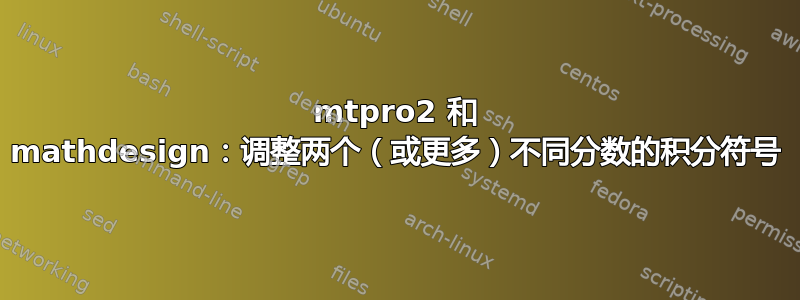
查看下面的图片可以观察到积分的两个符号的大小长度相同。
对于第一个积分(红色方框),大小是正确的。但对于第二个积分(紫色盒子)对于被积函数来说,这个尺寸太小了。我已经调整了第一个积分的长度。
但是,如何才能在我的源中添加一个命令(或多个具有不同大小的命令)以获得第二个积分的正确大小?
我看过这个链接大积分符号但我希望独自找到合适的长度。
非常感谢大家,我们随时欢迎任何进一步的建议。
这是我的 MWE:
\documentclass[12pt]{book}
\usepackage[top=2.5cm,bottom=2.5cm,left=3cm,right=3cm,headsep=10pt,a4paper]{geometry}
\usepackage{times} % Use the Times font for headings
\usepackage[lite]{mtpro2}
\usepackage{classico}
\usepackage{microtype} % Slightly tweak font spacing for aesthetics
\usepackage[utf8]{inputenc} % Required for including letters with accents
\usepackage[T1]{fontenc} % Use 8-bit encoding that has 256 glyphs
\usepackage{mathtools}
%%%%%%% New integral with mathdesign %%%%%%%
\makeatletter
\def\upintkern@{\mkern-7mu\mathchoice{\mkern-3.5mu}{}{}{}}
\def\upintdots@{\mathchoice{\mkern-4mu\@cdots\mkern-4mu}%
{{\cdotp}\mkern1.5mu{\cdotp}\mkern1.5mu{\cdotp}}%
{{\cdotp}\mkern1mu{\cdotp}\mkern1mu{\cdotp}}%
{{\cdotp}\mkern1mu{\cdotp}\mkern1mu{\cdotp}}}
\newcommand{\upiint}{\DOTSI\protect\UpMultiIntegral{2}}
\newcommand{\upiiint}{\DOTSI\protect\UpMultiIntegral{3}}
\newcommand{\upiiiint}{\DOTSI\protect\UpMultiIntegral{4}}
\newcommand{\upidotsint}{\DOTSI\protect\UpMultiIntegral{0}}
\newcommand{\UpMultiIntegral}[1]{%
\edef\ints@c{\noexpand\upintop
\ifnum#1=\z@\noexpand\upintdots@\else\noexpand\upintkern@\fi
\ifnum#1>\tw@\noexpand\upintop\noexpand\upintkern@\fi
\ifnum#1>\thr@@\noexpand\upintop\noexpand\upintkern@\fi
\noexpand\upintop
\noexpand\ilimits@
}
\futurelet\@let@token\ints@a
}
\makeatother
\DeclareFontFamily{OMX}{mdbch}{}
\DeclareFontShape{OMX}{mdbch}{m}{n}{ <->s * [1] mdbchr7v }{}%old 0.8
\DeclareFontShape{OMX}{mdbch}{b}{n}{ <->s * [1] mdbchb7v }{}%old 0.8
\DeclareFontShape{OMX}{mdbch}{bx}{n}{<->ssub * mdbch/b/n}{}
\DeclareSymbolFont{uplargesymbols}{OMX}{mdbch}{m}{n}
\SetSymbolFont{uplargesymbols}{bold}{OMX}{mdbch}{b}{n}
\DeclareMathSymbol{\upintop}{\mathop}{uplargesymbols}{82}
\DeclareMathSymbol{\upointop}{\mathop}{uplargesymbols}{"48}
\DeclareFontEncoding{MDB}{}{}
\DeclareFontFamily{MDB}{mdbch}{}
\DeclareFontShape{MDB}{mdbch}{m}{n}{ <->s * [0.8] mdbchrmb }{}
\DeclareFontShape{MDB}{mdbch}{b}{n}{ <->s * [0.8] mdbchbmb }{}
\DeclareFontShape{MDB}{mdbch}{bx}{n}{<->ssub * mdbch/b/n}{}
\DeclareFontSubstitution{MDB}{cmr}{m}{n}
\DeclareSymbolFont{mathdesignB}{MDB}{mdbch}{m}{n}%
\SetSymbolFont{mathdesignB}{bold}{MDB}{mdbch}{b}{n}%
\DeclareMathSymbol{\upintclockwise}{\mathop}{mathdesignB}{128}
\DeclareMathSymbol{\upointclockwise}{\mathop}{mathdesignB}{130}
\DeclareMathSymbol{\upointctrclockwise}{\mathop}{mathdesignB}{132}
\DeclareMathSymbol{\upoiint}{\mathop}{mathdesignB}{134}
\DeclareMathSymbol{\upoiiint}{\mathop}{mathdesignB}{136}
\makeatletter
\newcommand{\upint}{\DOTSI\upintop\ilimits@}
\newcommand{\upoint}{\DOTSI\upointop\ilimits@}
\makeatother
\begin{document}
\begin{equation}
dx=\upint \frac{dy}{\log x}
\end{equation}
\begin{equation}
\upint\frac{dy}{\sqrt{\dfrac{(n(y))^2}{c^2}-1}}
\end{equation}
\end{document}



